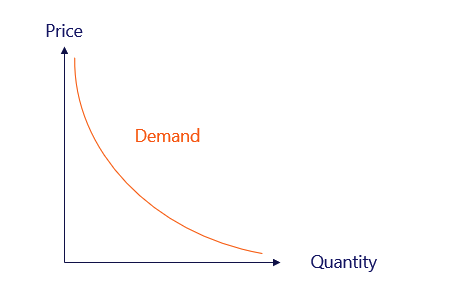It's about a 5 min. read.
An Overview on Pricing Research
Pricing a product or service correctly is critical to realizing profitability. Too often, pricing decisions are based on the cost to develop and produce the product or service. Price it too high, and no one will buy. Price it too low, and in addition to forgoing revenue, your buyers may question the quality.
One typical goal of pricing research is to understand price elasticity—the measure of the change in the quantity demanded of a product in relation to its price change. The typical microeconomics course presents the downward sloping demand curve.

As the price is raised, the quantity demand drops, and total revenue falls. In fact, most products exhibit a range of inelasticity. That is, demand may fall, but total revenue increases. It is the range of inelasticity that is of interest in determining the optimal price to charge for the product of service. Consider the following question: if the price of gasoline was raised 5¢ per gallon, would you drive fewer miles? If the answer is no, then we might raise the price of gas such that the quantity demanded is unchanged, but total revenue increases.
The range of inelasticity begins at the point where the maximum number of people are willing to try the product/service and ends when total revenue begins to fall. Where the marketer chooses to price the product/service depends upon the pricing strategy. A company should have a strategy for pricing a product/service throughout its product lifecycle.
There are two basic pricing strategies:
- Price skimming sets the initial price high to maximize revenue. As the product moves through the product lifecycle, the price typically drops. This strategy is often used for technology or products protected by patents. Apple and Samsung, for example, price each new mobile phone high, and as other competitors match performance characteristics, they lower price.
- Penetration pricing sets the initial price low to maximize trial. This pricing strategy tends to discourage competition, as economies of scale are often needed to make a profit. Understanding the goal, maximizing revenue versus maximizing share is part of the first step of pricing work.
The pricing researcher needs to understand this range of prices to make good strategic pricing decisions. There are many approaches to pricing research:
- Blunt approach: You can simply ask, “how much would you be willing to pay for this product/service?” In this approach, you typically need a large number of respondents to understand purchase intent at a variety of price points.
- Monadic concept: You can present the new product/service idea and ask, “how likely would you be to buy X product @ $2.99?” Monadic concept tests tend to over-estimate trial. This may be because prices given to respondents in a monadic concept test do not adequately reflect sales promotion activities. Respondents may think that the price given in the concept is the suggested retail price and that they are likely to buy on deal or with a coupon.
Monadic concept tests also require a higher base size. A typical concept test would require 200 to 300 completes per cell. The number of cells required would depend on the prices tested, but from the results we often see, it appears that these cells tend to over-estimate the range of inelasticity. Providing a competitive price frame might improve the results of monadic concept tests.
- van Westendorp’s Price Sensitivity Meter (PSM): The van Westendorp model is a good way to get at price elasticity and better understand the price consumers are willing to pay for a particular product or service. Developed by Dutch economist Peter van Westendorp, the underlying premise of this model is that there is a relationship between price and quality, and that consumers are willing to pay more for a higher quality product. The PSM requires 4 questions:
-
- At what price would you consider the product to be getting expensive, but you would still consider buying it? (EXPENSIVE)
- At what price would you consider the product too expensive and you would not consider buying it? (TOO EXPENSIVE)
- At what price would you consider the product to be getting inexpensive, and you would consider it to be a bargain? (BARGAIN)
- At what price would you consider the product to be so inexpensive that you would doubt its quality and would not consider buying it? (TOO CHEAP)
- The van Westendorp series does a reasonable job of predicting trial from a concept test without the need for multiple cells. This reduces the cost of pricing research and the likelihood that we do not test a price low enough. The prices given by respondents are believed to represent the actual out-of-pocket expenses. This permits the research some understanding of the effects of promotional activities (on shelf price discounts or coupons). The van Westendorp series will also permit the research to understand the potential trial at price points higher than those that might be tested in a monadic test.
- Conjoint Analysis: Conjoint is often used in early product development to assess the value of including certain features into the product/service option. While this does provide some indication of what attributes or features consumers would pay more for, it does not do a good job capturing the true value of these features. To do that, we need to show consumers a competitive set of offers from which to choose.
- Choice-based conjoint and Discrete Choice allow us to test products in a competitive setting, and to get a truer read on price elasticity and willingness to pay for certain features.
Choosing the correct pricing methodology is often dependent on where you are in the new product development process. The closer to market launch, discrete choice models offer the best insight into the actual potential in the market. Early in the development process, the other techniques provide guidance on how to price the product and how to choose a pricing strategy. Whatever stage of development or pricing strategy the technique you choose should yield results that help you make smarter more confident marketing decisions.

